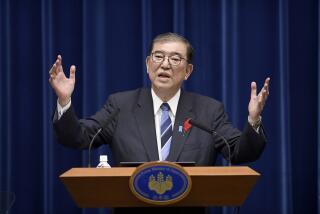Work Around Japan’s Revolving Prime-Minister Door : Policy: The U.S. should form a cohesive stand and stick to it, rather than trying to figure out each new government.
- Share via
TOKYO — The ultra right-wing campaign truck passes my home here: Rising Sun flags fluttering from the roof, “For an Independent Constitution” painted across its doors. Loudspeakers blare out support for just-resigned Justice Minister Shigeto Nagano’s provocative May 3 assertion that Japan’s invasion of Asia was a war of liberation, not aggression, and the Nanjing massacre “a fabrication.”
This dissent from apologies to Asia from former Prime Minister Morihiro Hosokawa and Emperor Akihito was ideological par for the new government of Prime Minister Tsutomu Hata and his backstage fixer Ichiro Ozawa, arguably the most nationalistic, right-leaning cabinet since World War II. Too many Americans, grasping for straws of hope, see Ozawa as the “can do” man who will put the politicians in charge of a recalcitrant bureaucracy and lead Japan to greater democracy, deregulation, open markets and “internationalization.” This is a serious misperception, compounded by the Clinton Administration’s decision to go easy on trade lest the new government (for which most Japanese see a life span of one to two months) collapse.
The tumult at Japan’s prime minister level strikes some foreign observers as a Gilbert and Sullivan farce, inexplicable for a nation normally so purposeful and “together.” It is neither. Japan’s long-term direction in the postwar period has always been laid down by the political arm, then left (too broadly, to be sure) to the permanent bureaucracy for implementation. After nearly a half-century of stability, political structures and ideologies are in long-delayed flux.
In the 1950s, Prime Minister Shigeru Yoshida placed Japan firmly on the track of a low military profile, close ties with the United States, acceptance of the new democratic constitution and concentration on the economic miracle those commitments made possible. Although the right wing of the ruling Liberal Democratic Party would have preferred to turn the clock back, the mainstream conservatives have adhered to that formula, with the large socialist opposition also blocking any return to political and military chauvinism. With the LDP finally out of power after too many money-tainted scandals, that old political configuration collapsed. Meanwhile, with no Cold War rationale for following the U.S. lead, foreign complaints about unfettered trade expansion and the lure of a prospering Asia, Japan now seeks a new definition of purpose.
To many Japanese, Hata’s “reformist” New Life Party and its prime mover, Ozawa, look too much like the old politics of veiled intentions, Byzantine coups and rough riding over democratic process. Voters were upset by Ozawa’s sudden and secretive launching of a new parliamentary group excluding the coalition’s largest partner, the Social Democratic Party. Having made painful policy concessions to get Hata elected, the Socialists withdrew, leaving Hata with a minority cabinet.
The rump alliance now combines the political nationalism of Hata’s Shinseito (dominated by former LDP right-wingers like Nagano) and the religious nationalism of the Buddhist-affiliated Komeito (Clean Government Party). Ozawa’s strategy is to lure additional LDP hawks to his fold, decimate the Socialist and smaller opposition parties through the “reformed” single-seat election district system and create two sibling conservative parties on the prewar model. The strategy’s basic goals include an expanded military role, a revision of the postwar constitution (shamefully “imposed” by the United States) and a more aggressive leadership of Asia.
There has been talk of rallying a more liberal-minded and less chauvinistic alternative alliance of the LDP left (cleansed of tainted money) and Socialist Democrats’ right (purged of Marxist hard-liners). A tall order--but a truer two-party system than Ozawa’s, and one that could hold Japan to its postwar democratic heritage.
In their eagerness to see Japan’s bureaucrats humbled, Americans should also mind who does the humbling. Actually, differences on trade issues between bureaucrats, politicians and the public are not nearly as wide as some Americans would hope. Japanese people still think of themselves more as job-holders, producers and loyal company workers than as individual consumers, and are grateful for protection, whatever leadership may supply it.
The United States should simply develop a visibly coordinated, persuasively argued and consistently applied Japan policy and stick with it. Nothing would better concentrate the mind of this, or any other new Japanese administration. If we don’t, America may have invented Tokyo’s best gambit yet for fending off market-opening pressures: just keep changing prime ministers. A punishment fitting the crime.
More to Read
Sign up for Essential California
The most important California stories and recommendations in your inbox every morning.
You may occasionally receive promotional content from the Los Angeles Times.













